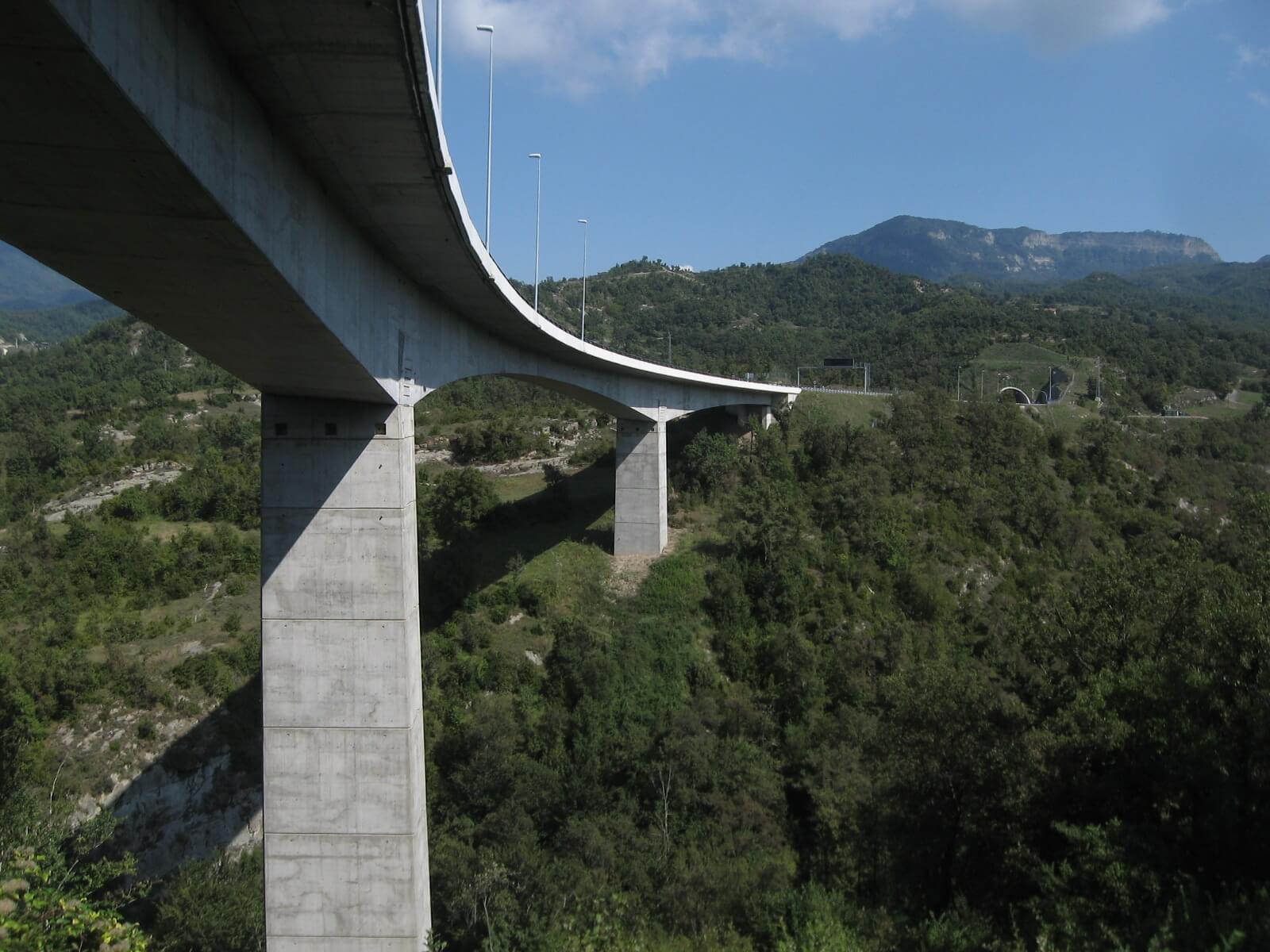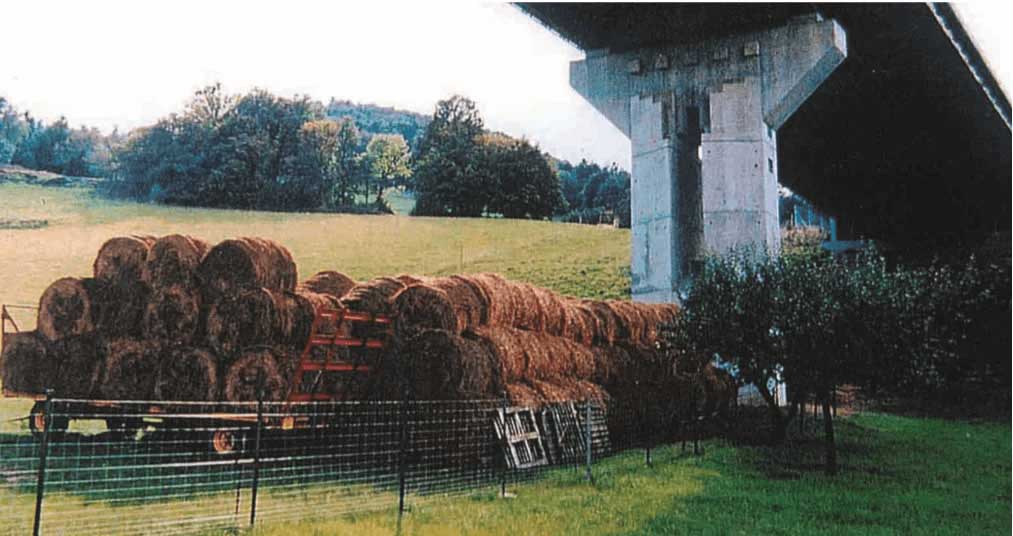General description and targets
Viaducts are large structures usually supported by pillars or arches, which carry linear transport infrastructure and could be easily adapted to enable the preservation of particularly valuable ecosystems and ecological corridors associated with floodplains and river valleys. Movements for a multitude of species, both vertebrates and invertebrates, are facilitated by the preservation and restoration of continuous terrestrial, riparian and aquatic habitats below viaducts. These are also known as ‘landscape underpasses’ as ecosystems below the structure are preserved just as landscape overpasses preserve ecosystems above (see Section 5.5.2 – Landscape overpasses and wildlife overpasses).
Land uses and activities compatible with fauna movements and preservation of ecological connectivity are required under the adapted viaducts. They must not be considered as wildlife passages when there is human disturbance or infrastructure with high traffic volume beneath.
In hilly areas a viaduct is a good technical solution to traverse valleys (Figure 5.5.23) which are often important ecological corridors and preferred routes for many animals, particularly when there is a watercourse present. In these cases, measures for wildlife need only ensure that habitat connection is maintained or restored when the infrastructure is completed.
A low viaduct is ecologically preferable to a solid embankment when transport infrastructure crosses a valley or other area lying lower than the alignment (Figure 5.5.24). By spanning above habitats, viaducts preserve ecosystems (Figure 5.5.25), provide optimal crossing structures for large mammals and are also of particular benefit to invertebrates and small vertebrates which require suitable habitats provided under a viaduct and would hardly use dark, dry and unvegetated underpasses. From an economic point of view, solid embankments are often a low cost solution to redeploy material excavated from other parts of the development. However, that a viaduct preserves particularly valuable ecosystems and ecological corridors outweighs any short term cost saving. This is because even low viaducts can provide better links and are suitable for a wider range of species than small underpasses built into an embankment.
Location
- Viaducts can be built wherever lower-lying ground has to be crossed by infrastructure. These structures are particularly recommended where a watercourse is present or becomes active under seasonal or extreme weather conditions.
- Wetlands (marshes) should be crossed by infrastructure only if construction is imperative and no alternative route can be found. In these cases, the infrastructure must utilise viaducts to span a wetland, avoiding the construction of any embankments.



Design
- Vegetation cover under the structure should be preserved or restored when possible maintaining the surrounding vegetation and ecological corridors. Where watercourses are present, the continuity of both terrestrial and aquatic habitats should be maintained.
- To allow continuous plant cover, a viaduct should have a minimum height of 5 m (distance from the soil to the viaduct platform). In wooded areas the minimum height should be 10 m.
- Viaduct length (distance between the crossing structure abutments) which could reach several hundred metres, must be maximized, preserving all landscape associated with the valley and avoiding the construction of embankments.
- Watercourses under the viaduct should be kept in a natural state, including the riverbed and riverbanks (Figure 5.5.26). Banks should allow the free movement of both semi-aquatic species such as otters or European mink, and terrestrial species moving along the riparian habitat.
- Where rivers are crossed, the viaduct length should stretch at least a further 10 m on both sides of the riverbank to allow the growth of riparian vegetation (Figure 5.5.27).
- Natural floodplains should be spanned completely by a viaduct.
- A lack of water and light may limit the growth of vegetation within underpasses. Depending on the target species or habitats the ground should be covered with earth and not with gravel or stones. If small roads or railways traverse under the viaduct, the use of tarmac should be avoided if possible. Open unobstructed ground should be provided (Figure 5.5.29 and Figure 5.5.30).
- When a viaduct carries wide infrastructure such as a motorway, a median gap separating the two circulation platforms provides extra light and rainwater to the ground under the viaduct, enhancing vegetation growth. However, narrow median gaps should be avoided to prevent noise disturbances caused by passing vehicles that can deter animals, especially large carnivores, from crossing.
- Under wider viaducts, zoning use of the land is necessary. Any roads running under the viaduct with night traffic should be screened off from animal movement corridors to reduce the impact of vehicle lights and noise.
- Rows of tree stumps, heaps of twigs or large stones can provide cover for small fauna and act as a link between habitats on each side of the structure (Figure 5.5.28).
- Screens could be installed on both sides of the viaduct to reduce noise and light disturbance to the habitats beneath. These screens should extend long enough (at least 50 m) at both ends of the structure to better protect surrounding habitats from traffic disturbance. To reduce risk of bird collision, screens should be opaque or provided with marks visible to birds to avoid the risk of bird collision (see Section 5.6.2 – Noise).
- Perimeter fencing of the transport infrastructure, with the fence ends well fixed to the viaduct abutments helps funnel any crossing animals under the viaduct.



Points for special attention
- The area under the viaduct must not be used for storing equipment or be blocked by agricultural machinery, parked cars, fences or other obstructions. Placing large rocks adjacent can help to avoid misuse of the passage.
- Long-term connection of habitats under the viaduct and the adjacent land must be ensured.

